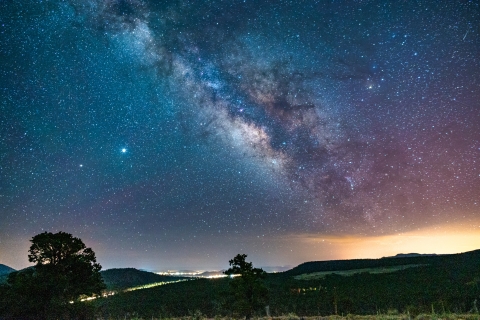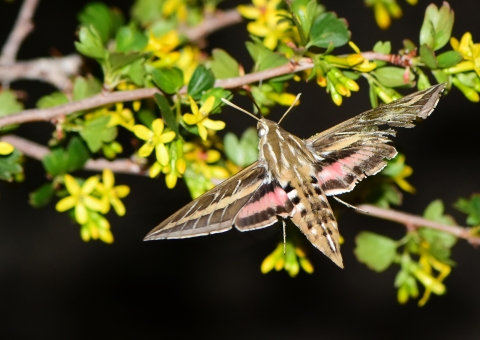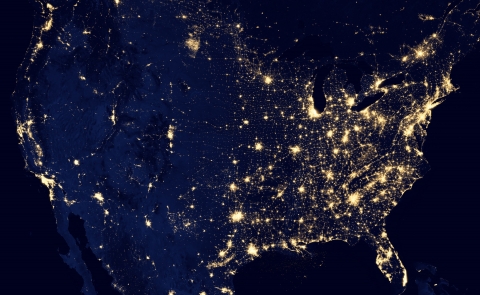Wildlife, plants and insects evolved to co-exist with the night sky, illuminated by the stars and moon. In a matter of decades, humans transformed the dark and naturally lit night sky to one that is glowing and brightened by artificial lights.
In 2016, 80% of the world was estimated to live under skyglow, a term used to describe the brightening of the night sky in areas where people live. The same year, the National Oceanic and Atmospheric Administration reported that an estimated one-third of humanity could no longer view the Milky Way Galaxy. In areas where this occurs, the soft glow of more than 100 billion stars is obscured by human-produced light. This excess of light at night is a form of pollution that can harm wildlife and plants.
Artificial light pollution is caused by any kind of outdoor lighting including streetlamps, porch lighting and even homes and office buildings that leave the lights on throughout the night without the use of shades or blinds.
Light pollution disrupts the natural sleep-wake cycle that repeats every 24 hours, known as the circadian rhythm. It also distorts natural rhythms in seasonal lighting that provide important cues to all life on earth – such as when to begin hibernating or migrating. It also changes the time that plants and animals spend awake or asleep, and the activities they typically carry out during waking hours.
The impacts of light on other species such as birds and sea turtles are more well-known; however, there are few studies that have evaluated the interaction between insects, pollinators, plants and artificial light.
“Although not well-studied, we are beginning to more clearly understand the impact light pollution has on insects and pollinators. This topic is emerging in more and more conversations,” said Melissa Burns, western monarch coordinator for the U.S. Fish and Wildlife Service.
The studies that have been conducted show artificial lighting can drastically affect the behavior of insects and pollinators, and therefore the ability of plants to produce fruit and reproduce.
In 2014, a group of scientists in the United Kingdom studied the effects of streetlamps on moths. The scientists found that 70% the moths flew towards the streetlamps and away from flowering plants. This resulted in a reduction of plant pollination.
A separate study conducted in 2017 also found that nighttime pollinators were less likely to visit plants underneath artificial light, also reducing pollination and fruit produced by the plants. The researchers found that approximately 62% fewer insects visited the plants in a meadow illuminated at night with LED streetlamps than a meadow naturally lit by the moon.
Both studies show that the presence of artificial light at night deters pollinators from their nightly routine. Some nocturnal pollinators are attracted to and disoriented by artificial light, expending precious energy and distracting them from their nighttime routines and pollination duties. Others are deterred by well-lit areas. In both cases, the result is a disruption in nighttime pollination and fewer plants producing fruit and reproducing. Researchers are not exactly sure why this happens, but there are several theories.
"Artificial lighting at night also increases a nocturnal pollinator's risk of predation because they are easier to see. Their ability to see and avoid predators is also reduced by the lighting – so they may avoid it. This risk is thought to be one of the factors contributing to declines in nocturnal pollinators globally,” Burns added.
More research is needed to better understand how exactly artificial lights impact plants and pollinators and the long-term implications. Luckily, each of us can adjust how we use outdoor lighting through the tips below and help our backyard pollinators. These actions also have the added bonus of helping other species of wildlife, reducing energy use and costs and contributing towards a healthier future in the face of a changing climate.
Tips for reducing skyglow at home:
Keep light indoors: close blinds or curtains drawn at night to keep the light inside.
Color matters: use warmer colored light bulbs and minimize blue-violet light (light bulbs with a temperature of no more than 3000 kelvins).
Use outdoor light where and when you need it: control your lighting through motion detectors, timers or dimmers. Use motion-triggered lights to address safety concerns.
Keep light where you want it: properly shield all outdoor lights to eliminate light pollution drifting into the sky.
Visit International Dark Sky Certified places (and Refuges!) to learn more about light pollution and experience the night sky! The U.S. Fish and Wildlife Service manages two internationally certified places: Valle de Oro National Wildlife Refuge in New Mexico is certified as an Urban Dark Sky Place and Lost Trail National Wildlife Refuge in Montana is certified as an International Dark Sky Sanctuary.
Plant a moon garden for nighttime pollinators.









